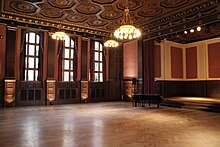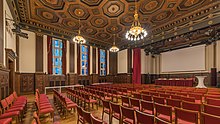Hansa Studios

The Hansa Studios (formerly: Hansa-Tonstudios ) comprise several former and still active recording studios in Berlin .
history
In addition to a smaller recording studio at the headquarters of Hansa Musik Produktion in Wittelsbacherstraße in the Wilmersdorf district , the brothers Thomas and Peter Meisel had been producing the Ariola Eurodisc in the Sonopress recording studio in the Meistersaal at Köthener Straße 38 in the Kreuzberg district since 1965 . In order to be independent of music production in terms of recording technology, the Meisel brothers founded Hansa Tonstudio GmbH in 1972 and converted the fourth floor of Nestorstrasse 8/9 in Halensee into a recording studio. The studio called Hansa I was opened just in time for the 1973 radio exhibition . Numerous recordings were made by Bernd Clüver , Marianne Rosenberg , Bernhard Brink , Peter Orloff and Drafi Deutscher . But foreign artists were also guests, for example. B. Albert Hammond with the production of his hit song Down by the River or the Indian singer Asha Puthli .
In 1974 the studio was given up after a change of house owner, combined with unacceptable rental conditions for Hansa. Almost at the same time, Hansa took over the studio on Köthener Straße (now: Hansa Studio II) as the main tenant. The Meistersaal had an excellent reputation due to its excellent acoustics. In addition to the hit recordings by the well-known Hansa interpreters, productions from all other areas of music took place there: opera productions, e.g. B. with Anna Moffo as Carmen under Lorin Maazel , the last operetta recordings by Robert Stolz , as well as productions by Rudolf Schock , Ivan Rebroff or Paul Kuhn with his SFB dance orchestra. But film music was also recorded and synchronizations took place. Jack White was happy to use the studio and produced his artists Tony Marshall , Lena Valaitis , Jürgen Marcus , Renate & Werner Leismann , Nina & Mike and Tanja Berg ; but also CBS produced numerous national artists here.
Not only the good acoustics of the Meistersaal with its splendid ambience of historical ambiguity - the great hall had served as a dance hall for SS officers before 1945 - also the unique view from the window of the control room of the Berlin Wall fascinated international artists, who soon opened the studio affectionately titled “Studio by the Wall” or “Big Hall by the Wall”.
Above all, David Bowie made the studio famous in the international music world with his Berlin trilogy ( Low , “Heroes” and Lodger and especially with the song “Heroes” , inspired by the sight of the Berlin Wall , 1977). Iggy Pop , who produced there with Bowie, was followed by Depeche Mode , Marillion , Falco , Nick Cave , Snow Patrol , U2 and other rock and pop greats.
The house at Köthener Straße 38 became the property of the Meisel brothers in 1976 and was consistently expanded. Studio 3 was built in a former cinema on the ground floor, a utility room - initially intended as a practice room - was initially used as a copy room and later as Studio 4. Finally, the new Studio 1 moved under the roof to replace the studio on Nestorstrasse.
Furnishing
The equipment of the studios was continuously adapted to the advances in sound technology, computer-controlled mixing consoles , digital recording technology or multi-channel sound came along . In addition, the studio was comparatively inexpensive in the 1980s, compared to similar studios in other cities and especially the United Kingdom , thanks to the Berlin funding at the time . During the production of Depeche Mode's Construction Time Again (1983) it already had a 64-channel mixer, and even then Alan Wilder praised the fact that everything was computerized and that sophisticated mixes were possible.
When a change in music production became apparent at the end of the 1980s and the demand for studios of this size steadily declined, Thomas Meisel decided to dismantle studios 2 and 3 and restore the Meistersaal to its original state. This went hand in hand with a renovation of the entire building. Today the Hansa recording studios include Studio 1, two further production studios, a suite and the former “mixing studio”, which is currently rented by the Swedish producer Michael Ilbert.
Berlin Music Tours
The area around Köthener Strasse underwent a sudden change in the 1990s after German reunification and the subsequent renovation of Potsdamer Platz . Many historically relevant buildings were demolished or were suddenly at risk of having to give way to real estate projects. For example, the former sound engineer Thilo Schmied began to offer guided tours through the Hansa studios in a pilot project, at first sporadically and then systematically, in order to make the cultural-historical achievement and importance of the place for international contemporary music culture accessible to the public. Today the Berlin Music Tours are an integral part of the Hansastudios event program and have meanwhile been extended to all of Berlin, so it is also possible to visit the former homes or apartments of legendary musicians such as David Bowie or Iggy Pop.
Web links
- Website of the Hansa recording studios
- Hansa Studios by the wall 1976–1990 , documentary, 90 min, Sky Arts 2017, online
Individual evidence
- ↑ a b Klaus Eidam , Rudolf Schröder : The Hit Factory. Chronicle of a Berlin music publisher. Edition Intro Meisel GmbH , Berlin 2001, ISMN M-50066-230-3.
- ↑ a b Personal communication from a long-standing Hansa employee.
- ↑ David Buckley: Strange Fascination David Bowie: The Definitive Story . Virgin, London 1999, ISBN 0-7535-0457-X , pp. 323-326.
- ↑ Jonathan Miller: Stripped: Depeche Mode . Omnibus Press, 2004, ISBN 1844494152 , pp. 161-162.
- ↑ Brochure on the reopening of the Meistersaal, Meisel Musikverlag, Berlin 1994.
- ↑ Heroes' deeds in the Hansa Studios. In: Baden's latest news , April 2, 2017.
Coordinates: 52 ° 30 ′ 22.75 " N , 13 ° 22 ′ 38.01" E

